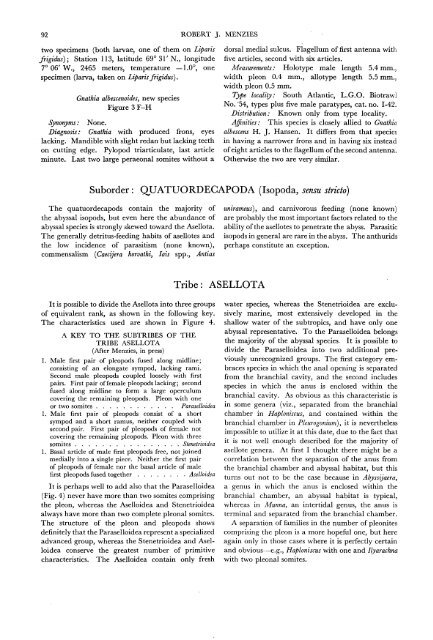The Isopods of Abyssal Depths in the Atlantic Ocean
The Isopods of Abyssal Depths in the Atlantic Ocean
The Isopods of Abyssal Depths in the Atlantic Ocean
You also want an ePaper? Increase the reach of your titles
YUMPU automatically turns print PDFs into web optimized ePapers that Google loves.
92<br />
two specimens (both larvae, one <strong>of</strong> <strong>the</strong>m on Liparis<br />
frigidus); Station 113, latitude 69°31'N., longitude<br />
7° 06' W., 2465 meters, temperature — 1.0°, one<br />
specimen (larva, taken on Liparis frigidus).<br />
Gnathia albescenoides, new species<br />
Figure 3 F-H<br />
Synonyms: None.<br />
Diagnosis: Gnathia with produced frons, eyes<br />
lack<strong>in</strong>g. Mandible with slight redan but lack<strong>in</strong>g teeth<br />
on cutt<strong>in</strong>g edge. Pylopod triarticulate, last article<br />
m<strong>in</strong>ute. Last two large peraeonal somites without a<br />
It is possible to divide <strong>the</strong> Asellota <strong>in</strong>to three groups<br />
<strong>of</strong> equivalent rank, as shown <strong>in</strong> <strong>the</strong> follow<strong>in</strong>g key.<br />
<strong>The</strong> characteristics used are shown <strong>in</strong> Figure 4.<br />
A KEY TO THE SUBTRIBES OF THE<br />
TRIBE ASELLOTA<br />
(After Menzies, <strong>in</strong> press)<br />
1. Male first pair <strong>of</strong> pleopods fused along midl<strong>in</strong>e;<br />
consist<strong>in</strong>g <strong>of</strong> an elongate sympod, lack<strong>in</strong>g rami.<br />
Second male pleopods coupled loosely with first<br />
pairs. First pair <strong>of</strong> female pleopods lack<strong>in</strong>g; second<br />
fused along midl<strong>in</strong>e to form a large operculum<br />
cover<strong>in</strong>g <strong>the</strong> rema<strong>in</strong><strong>in</strong>g pleopods. Pleon with one<br />
or two somites Paraselloidea<br />
1. Male first pair <strong>of</strong> pleopods consist <strong>of</strong> a short<br />
sympod and a short ramus, nei<strong>the</strong>r coupled with<br />
second pair. First pair <strong>of</strong> pleopods <strong>of</strong> female not<br />
cover<strong>in</strong>g <strong>the</strong> rema<strong>in</strong><strong>in</strong>g pleopods. Pleon with three<br />
somites Stenetrioidea<br />
1. Basal article <strong>of</strong> male first pleopods free, not jo<strong>in</strong>ed<br />
medially <strong>in</strong>to a s<strong>in</strong>gle piece. Nei<strong>the</strong>r <strong>the</strong> first pair<br />
<strong>of</strong> pleopods <strong>of</strong> female nor <strong>the</strong> basal article <strong>of</strong> male<br />
first pleopods fused toge<strong>the</strong>r Aselloidea<br />
It is perhaps well to add also that <strong>the</strong> Paraselloidea<br />
(Fig. 4) never have more than two somites compris<strong>in</strong>g<br />
<strong>the</strong> pleon, whereas <strong>the</strong> Aselloidea and Stenetrioidea<br />
always have more than two complete pleonal somites.<br />
<strong>The</strong> structure <strong>of</strong> <strong>the</strong> pleon and pleopods shows<br />
def<strong>in</strong>itely that <strong>the</strong> Paraselloidea represent a specialized<br />
advanced group, whereas <strong>the</strong> Stenetrioidea and Aselloidea<br />
conserve <strong>the</strong> greatest number <strong>of</strong> primitive<br />
characteristics. <strong>The</strong> Aselloidea conta<strong>in</strong> only fresh<br />
ROBERT J. MENZIES<br />
dorsal medial sulcus. Flagellum <strong>of</strong> first antenna with<br />
five articles, second with six articles.<br />
Measurements: Holotype male length 5.4 mm.,<br />
width pleon 0.4 mm., allotype length 5.5 mm.,<br />
width pleon 0.5 mm.<br />
Type locality: South <strong>Atlantic</strong>, L.G.O. Biotrawl<br />
No. "54, types plus five male paratypes, cat. no. 1-42.<br />
Distribution: Known only from type locality.<br />
Aff<strong>in</strong>ities: This species is closely allied to Gnathia<br />
albescens H. J. Hansen. It differs from that species<br />
<strong>in</strong> hav<strong>in</strong>g a narrower frons and <strong>in</strong> hav<strong>in</strong>g six <strong>in</strong>stead<br />
<strong>of</strong> eight articles to <strong>the</strong> flagellum <strong>of</strong> <strong>the</strong> second antenna.<br />
O<strong>the</strong>rwise <strong>the</strong> two are very similar.<br />
Suborder : QUATUORDECAPODA (Isopoda, sensu stricto)<br />
<strong>The</strong> quatuordecapods conta<strong>in</strong> <strong>the</strong> majority <strong>of</strong><br />
<strong>the</strong> abyssal isopods, but even here <strong>the</strong> abundance <strong>of</strong><br />
abyssal species is strongly skewed toward <strong>the</strong> Asellota.<br />
<strong>The</strong> generally detritus-feed<strong>in</strong>g habits <strong>of</strong> asellotes and<br />
<strong>the</strong> low <strong>in</strong>cidence <strong>of</strong> parasitism (none known),<br />
commensalism [Caecijera horvathi, Iais spp., Antias<br />
Tribe: ASELLOTA<br />
unirameus), and carnivorous feed<strong>in</strong>g (none known)<br />
are probably <strong>the</strong> most important factors related to <strong>the</strong><br />
ability <strong>of</strong> <strong>the</strong> asellotes to penetrate <strong>the</strong> abyss. Parasitic<br />
isopods <strong>in</strong> general are rare <strong>in</strong> <strong>the</strong> abyss. <strong>The</strong> anthurids<br />
perhaps constitute an exception.<br />
water species, whereas <strong>the</strong> Stenetrioidea are exclusively<br />
mar<strong>in</strong>e, most extensively developed <strong>in</strong> <strong>the</strong><br />
shallow water <strong>of</strong> <strong>the</strong> subtropics, and have only one<br />
abyssal representative. To <strong>the</strong> Paraselloidea belongs<br />
<strong>the</strong> majority <strong>of</strong> <strong>the</strong> abyssal species It is possible to<br />
divide <strong>the</strong> Paraselloidea <strong>in</strong>to two additional previously<br />
unrecognized groups. <strong>The</strong> first category embraces<br />
species <strong>in</strong> which <strong>the</strong> anal open<strong>in</strong>g is separated<br />
from <strong>the</strong> branchial cavity, and <strong>the</strong> second <strong>in</strong>cludes<br />
species <strong>in</strong> which <strong>the</strong> anus is enclosed with<strong>in</strong> <strong>the</strong><br />
branchial cavity. As obvious as this characteristic is<br />
<strong>in</strong> some genera (viz., separated from <strong>the</strong> branchial<br />
chamber <strong>in</strong> Haploniscus, and conta<strong>in</strong>ed with<strong>in</strong> <strong>the</strong><br />
branchial chamber <strong>in</strong> Pleurogonium), it is never<strong>the</strong>less<br />
impossible to utilize it at this date, due to <strong>the</strong> fact that<br />
it is not well enough described for <strong>the</strong> majority <strong>of</strong><br />
asellote genera. At first I thought <strong>the</strong>re might be a<br />
correlation between <strong>the</strong> separation <strong>of</strong> <strong>the</strong> anus from<br />
<strong>the</strong> branchial chamber and abyssal habitat, but this<br />
turns out not to be <strong>the</strong> case because <strong>in</strong> Abyssijaera,<br />
a genus <strong>in</strong> which <strong>the</strong> anus is enclosed with<strong>in</strong> <strong>the</strong><br />
branchial chamber, an abyssal habitat is typical,<br />
whereas <strong>in</strong> Munna, an <strong>in</strong>tertidal genus, <strong>the</strong> anus is<br />
term<strong>in</strong>al and separated from <strong>the</strong> branchial chamber.<br />
A separation <strong>of</strong> families <strong>in</strong> <strong>the</strong> number <strong>of</strong> pleonites<br />
compris<strong>in</strong>g <strong>the</strong> pleon is a more hopeful one, but here<br />
aga<strong>in</strong> only <strong>in</strong> those cases where it is perfectly certa<strong>in</strong><br />
and obvious—e.g., Haploniscus with one and Ilyarachna<br />
with two pleonal somites.

















